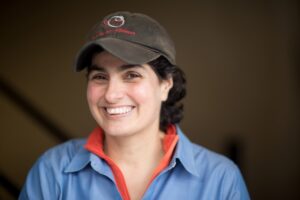Science@MIT letter from the Dean

Nergis Mavalvala, the Curtis and Kathleen Marble Professor of Astrophysics, is dean of MIT’s School of Science. Photo: Bryce Vickmark
My fellow alumni and friends,
This last decade has been an explosive one for astrophysics and space research. Released in fall 2021, the National Academies’ Decadal Survey on Astronomy and Astrophysics outlined the upcoming decade’s most compelling science goals and set the funding priorities for national agencies such as NASA and NSF. Not surprisingly, scientists at MIT Kavli Institute (MKI) for Astrophysics and Space Research are playing key roles in projects and missions that have gotten the Astro2020 stamp of approval.
These scientists include veteran researchers, such as Deepto Chakrabarty ’88, the new head in the Department of Physics and up-and-coming superstars such as Erin Kara, who was the keynote speaker for our breakfast talks speaker series. Thank you to those of you who could join us for our first in-person science talk in more than two years; and I hope we can continue the trend into the spring. You can read more about how Erin’s research elucidates the physics behind how black holes grow and affect their environments.
In the upcoming issue of Science@MIT, we introduce you to some new astronomical instrumentation MKI scientists are developing to study the unseen: from high-energy X-rays to light from the universe’s first stars. Some instruments are already up and running in the desert of Chile; some are waiting to be incorporated into rockets to scan the sky. Others are in the planning stages and may take decades to start taking in data. A scientist’s research journey can often be a long one — and supporters, such as Curt Marble, ’63 help launch those research dreams. You can read about Curt’s interest in supporting our MKI scientists. It gives me great pleasure to also acknowledge the research enabled in my own group through Curt’s support and friendship.
In other philanthropic news, you can read about the new MIT bionics center established by K. Lisa Yang’s $24 million gift. At the helm is Ed Boyden, the Y. Eva Tan Professor in Neurotechnology at MIT, and Hugh Herr, professor of media arts and sciences at the MIT Media Lab. Ed is a renowned creator of tools to analyze and control the brain. Hugh is a pioneer in the development of bionic limbs to improve mobility for those with physical disabilities. Together with scientists including Nancy Kanwisher, an expert in perception and cognition, this team will develop new bionic interventions for our brains and bodies. You can read about other scientific supporters, such as Barrie Zesiger who make it possible for our graduate students to devote themselves to the science that excites them and inspires us.
For an in-depth profile about one of our amazing graduate students who is looking at underpinnings of mind and machines, you can turn back to the beginning of the issue to read about the research of recent mathematics PhD recipient Juncal Arbelaiz. Doctorate in hand, Juncal is off to Princeton for a postdoc appointment to explore the reliability and robustness of artificial and biological interfaces.
Our life sciences program continues to thrive, in no small part due to the generous gift of Paul Schimmel whose transformative $50 million gift has provided funding for many graduate students across the Institute. The MIT Schimmel Family Program for Life Sciences still has opportunities for doubling the impact of Paul’s gift. If that area of research speaks to your passions or interests, please do reach out to Amy Keating, our new head of the Department of Biology. You can read about Amy’s research and her vision for an integrated and newly invigorated biological and life sciences program.
Interdisciplinarity and integration with life sciences is the life’s work of Brandon Ogbunu, one of our two MIT Martin Luther King, Jr. visiting scholars. You can read about Brandon’s research on protein evolution and his collaboration with Matt Shoulders in the Department of Chemistry. The MLK scholars program has been a wonderful way to grow our research partnerships — and most recently, our faculty.
I’m thrilled to share that Robert Gilliard, a recent MLK scholar who worked with inorganic chemist Kit Cummins, will join the Department of Chemistry as a fully tenured faculty member. I look forward to learning more about Robert and his research as he returns to the ’Tute this semester.
I hope these and other stories from the School of Science will continue to inspire you to set your sights on the stars.
With my very best wishes,
Dean Nergis Mavalvala PhD ‘97